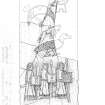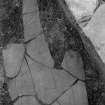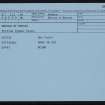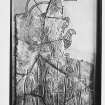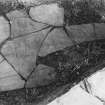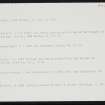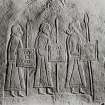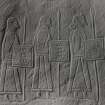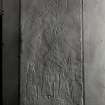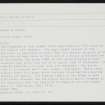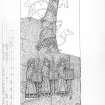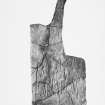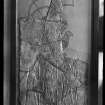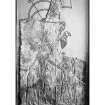Brough Of Birsay, Pictish Symbol Stone
Pictish Symbol Stone (Pictish)
Site Name Brough Of Birsay, Pictish Symbol Stone
Classification Pictish Symbol Stone (Pictish)
Canmore ID 1797
Site Number HY22NW 1.01
NGR HY 2398 2850
Datum OSGB36 - NGR
Permalink http://canmore.org.uk/site/1797
- Council Orkney Islands
- Parish Birsay And Harray
- Former Region Orkney Islands Area
- Former District Orkney
- Former County Orkney
Brough of Birsay 1, Orkney, Pictish symbol stone fragments
Measurements: H 1.84m, W 0.80m, D 0.03m
Stone type: old red sandstone
Place of discovery: HY 2398 2850
Present location: National Museums Scotland, Edinburgh (X.IB.243)
Evidence for discovery: found during excavations in 1935 close to the west wall of the graveyard.
Present condition: broken into sixteen fragments, now mounted together.
Description
One broad face of this slab bears carving in incision and low relief. The upper part of the slab is incised with four Pictish symbols, one above the other: a disc and indented rectangle (or ‘mirror-case’), above a crescent and V-rod, a Pictish beast and an eagle on foot, the latter two facing right. Beneath the symbols and carved in a mixture of low relief and incision are three warriors walking to the right. Each is dressed in a long belted tunic and bears a sword, square shield and spear. All have oval eyes and shoulder-length hair and the front two are bearded, and the higher social status of the foremost warrior is indicated by details such as his curled hair, luxuriant beard and greater height, along with a more elaborately decorated shield.
Date: seventh or eighth century.
References: Curle 1982, 91-2, 97; Fraser 2008, no 166; Scott & Ritchie 2014, no 1.
Compiled by A Ritchie 2016.
Brough of Birsay 6 (St Peter), Orkney, ogham-inscribed fragment
Measurements: H c 0.37, W c 0.24m, D c 0.05m
Stone type: old red sandstone
Place of discovery: HY 2398 2850
Present location: lost.
Evidence for discovery: found on the beach below the eroding Norse buildings during the 1930s excavations.
Present condition:
Description
This is an incomplete graffito inscription carved on to a stone in a wall, but the short length that survives is difficult to interpret.
Date: early medieval.
References: Forsyth 1996, 81-5 (no 2).
Compiled by A Ritchie 2017
Brough of Birsay 7 (St Peter), Orkney, ogham-inscribed fragment
Measurements: L 0.32m, W 0.35m, H 0.06m
Stone type: sandstone
Place of discovery: HY 2398 2850
Present location: The Orkney Museum, Kirkwall.
Evidence for discovery: found during excavation in 1980, re-used as a paving stone in a context dated by radiocarbon analysis.
Present condition: weathered.
Description
One narrow face of the fragment bears the remains of an inscription in bind ogham letter set on a stem line, of which the interpretation is uncertain.
Date: seventh century.
References: Forsyth 1996, 85-91 (no 3).
Compiled by A Ritchie 2017
Brough of Birsay 2 (St Peter), Orkney, cross-slab
Measurements: H 0.86m+, W 0.55m
Stone type: old red sandstone
Place of discovery: HY 2398 2850
Present location: in the site museum.
Evidence for discovery: found during excavations around 1936 in the graveyard, close to the apse of the church. It was set upright and later taken into the museum.
Present condition: weathered.
Description
This rectangular slab is incised on one broad face with an outline cross with slightly expanded arms and a faint central circle.
Date: seventh or eighth century.
References: RCAHMS 1946, fig 53; Scott & Ritchie 2014, no 17.
Compiled by A Ritchie 2016
Brough of Birsay 3 (St Peter), Orkney, recumbent cross-slab
Measurements: L 1.65m, W 0.35m tapering to 0.28m
Stone type: old red sandstone
Place of discovery: HY 2398 2850
Present location: in the site museum.
Evidence for discovery: found during excavations around 1936 in the graveyard, lying recumbent over a grave close to the west wall of the graveyard.
Present condition: weathered.
Description
One broad face of this long rectilinear slab is incised with two ring-headed crosses set shaft-end to shaft-end. Each has expanded wedge-shaped arms and the larger cross has small circular armpits and an expanded shaft. In both cases there is a fat ring around the shaft, double on the smaller cross, the effect of which is to give a sense of perspective of crosses set in circular bases.
Date: eleventh century.
References: RCAHMS 1946, fig 53; Curle 1982, 91; Scott & Ritchie 2014, no 18.
Compiled by A Ritchie 2016
Brough of Birsay 4 (St Peter), Orkney, portable cross-slab fragment
Measurements: H 120mm, W 150mm. D 22mm
Stone type: old red sandstone
Place of discovery: HY 2398 2850
Present location: in the site museum.
Evidence for discovery: found during excavations around 1936 as an unstratified artefact south of the graveyard.
Present condition: broken and the right-hand side of the cross is missing.
Description
This fragment is incised with an outline cross defined by a double border, standing on a rectangular base outlined with a single line. The side-arms are slightly shorter than the upper arm, and all three have rectangular terminals.
Date: ninth century.
References: Curle 1982, 92; Scott & Ritchie 2014, no 28.
Compiled by A Ritchie 2016
Brough of Birsay 8 (St Peter), Orkney, rune-inscribed fragment
Measurements: L 0.87m, W 0.16, D 0.09m
Stone type: sandstone
Place of discovery: HY 2398 2850
Present location: National Museums Scotland, Edinburgh (X.IB.191).
Evidence for discovery: found in 1921 re-used in the external face of the north chancel wall of the church, and soon after donated to NMAS.
Present condition: damaged..
Description
The narrow rune-inscribed face of this fragment was hidden within the wall. The inscription includes the personal name ‘Philippus’.
Date: early medieval.
References: Marwick 1922; Barnes & Page 2006, OR 6, 166-70.
Compiled by A Ritchie 2017
Brough of Birsay 9 (St Peter), Orkney, rune-inscribed fragments
Measurements: L 0.74m, W 0.30m, H 0.08m
Stone type: old red sandstone
Place of discovery: HY 2398 2850
Present location: in the site museum.
Evidence for discovery: found in 1934 during excavation of the graveyard, probably having been reused as building material in the twelfth-century church.
Present condition: broken lengthwise and broken into two fragments transversely.
Description
The runes are carved along the narrow face of the stone and represent the lower part of the letters, along with two mid-line crosses. This is probably a commemorative inscription, and it may be part of the same stone as nos 10 and 11.
Date: eleventh century.
References: Barnes & Page 2006, OR 8, 176-9.
Compiled by A Ritchie 2017
Brough of Birsay 10 (St Peter), Orkney, rune-inscribed fragment
Measurements: L 0.66m, W 0.30m, H 0.07m
Stone type: old red sandstone
Place of discovery: HY 2398 2850
Present location: in the site museum.
Evidence for discovery: found in 1934 during excavation of the graveyard, probably having been reused as building material in the twelfth-century church.
Present condition: broken lengthwise.
Description
The runes are carved along the narrow face of the stone and represent the lower part of the letters. This is probably a commemorative inscription, and it may be part of the same stone as nos 9 and 11.
Date: eleventh century.
References: Barnes & Page 2006, OR 9, 179-80.
Compiled by A Ritchie 2017
Brough of Birsay 11 (St Peter), Orkney, rune-inscribed fragment
Measurements: L 0.70m, H 0.06m
Stone type: old red sandstone
Place of discovery: HY 2398 2850
Present location: built into the base of the south wall of the church.
Evidence for discovery: noticed during excavations in the 1930s.
Present condition: worn and damaged.
Description
The runes are carved along the narrow face of the stone and represent the lower part of the letters. This is probably a commemorative inscription, and it may be part of the same stone as nos 9 and 10.
Date: eleventh century.
References: Barnes & Page 2006, OR 16, 180-1.
Compiled by A Ritchie 2017
Brough of Birsay 5 (St Peter), Orkney, ogham-inscribed fragment
Measurements: H c0.63m, W c 0.31m, D c 0.12m
Stone type: sandstone
Place of discovery: HY 2398 2850
Present location: lost.
Evidence for discovery: found during the 1930s excavations re-used as a building stone.
Present condition:
Description
This is an incomplete graffito inscription carved on to a stone in a wall, and it is possible that it includes a Norse personal name.
Date: early medieval.
References: Forsyth 1996, 76-81 (no 1).
Compiled by A Ritchie 2017
HY22NW 1.01 2398 2850
The fragments of this symbol stone were found in 1935 close to the side of the cemetery. The most recent account of the discovery is published in Curle (1982, 91); earlier accounts of the stone having been found at the W end of a triple grave must now be discounted. The stone (NMAS IB 243) would originally have measured some 2m by 0.8m and it is merely 25mm in thickness. The symbols comprise a circular disc and rectangle ('the mirror case'), a crescent and V-rod, 'beast', and eagle. Below these symbols there is a panel which contains three warriors bearing shields and spears. The leading figure of the three is more elaborately dressed, and the shield contains spiral elements in its decoration that are identical to those on the disc symbol above it (see C L Curle, 1982).
Information from RCAHMS 1985.





















